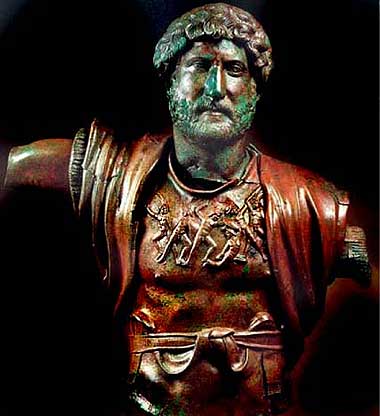Editor, H. S. (2002;2002). BAR 23:06 (Nov/Dec 1997). Biblical Archaeology Society.
Roman Jerusalem
Hadrian: A Portrait in Bronze
By Molly Dewsnap

David Harris/Collection Israel Museum
Vigorous, muscular and armorclad, Emperor Hadrian–in the rare bronze sculpture featured on the cover of this issue–appears as the adept military leader who dominated the Mediterranean world from 117 to 138 C.E. His commanding appearance is recognizable from marble statues, reliefs, coins and even ancient texts.
The portrayal of Hadrian in the Historia Augusta , a fourth-century C.E. compilation of imperial biographies, could be a description of this very statue: "He was tall of stature and elegant in appearance; his hair was curled on a comb, and he wore a full beard to cover up the natural blemishes on his face." But it is extremely unusual to find such a well-preserved bronze statue of Hadrian, perhaps because this precious metal, unlike marble, can be melted down and reused.
An American tourist named Morton Leventhal discovered the statue in 1975, while searching for coins on the ancient mound of Tel Shalem, in the Jordan River Valley.1 When his metal detector went off, he dug down more than a foot before striking the larger-than-life head, torso and other fragments–a find estimated at the time to be worth three or four million dollars. He brought the pieces to a nearby kibbutz.
The find immediately prompted the Department of Antiquities (today the Israel Antiquities Authority) to excavate the site: Led by Gideon Foerster, a team of archaeologists uncovered not only more of the statue but also the second-century C.E. Roman fort where it had stood. Earthworks surrounded the stronghold of mudbrick buildings, strategically located above the road leading south through the Jordan Valley from Beth-Shean (Roman Scythopolis) to Jericho. Arrowheads and catapult stones attested to the compound's military nature.
1
See Suzanne Singer, "Rare Bronze Statue of Hadrian Found by Tourist," BAR 02:04. When Israel's Department of Antiquities refused to release color photos of the statue or to allow BAR to take a new one 20 years ago, this magazine initiated a grassroots postcard campaign, encouraging readers to send the message "Free Hadrian" to the Minister of Culture at the Embassy of Israel. For an account of BAR 's overwhelmingly unsuccessful attempt at that time to publish a color photograph of this statue on its cover, see "Free Hadrian," BAR 14:03.
next page >
page 1:2
 
|
Biblical Archaeology Review
This article is part of the Biblical Archaeology Review Archive CD-ROM. Click here to learn more.
|
|